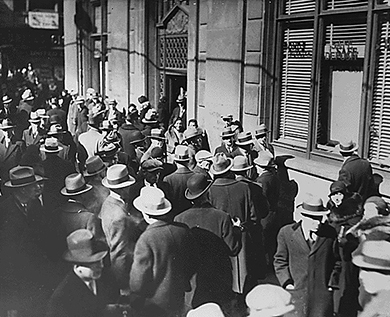| << Chapter < Page | Chapter >> Page > |

The contagion effect of the crash grew quickly. With investors losing billions of dollars, they invested very little in new or expanded businesses. At this time, two industries had the greatest impact on the country’s economic future in terms of investment, potential growth, and employment: automotive and construction. After the crash, both were hit hard. In November 1929, fewer cars were built than in any other month since November 1919. Even before the crash, widespread saturation of the market meant that few Americans bought them, leading to a slowdown. Afterward, very few could afford them. By 1933, Stutz, Locomobile, Durant, Franklin, Deusenberg, and Pierce-Arrow automobiles, all luxury models, were largely unavailable; production had ground to a halt. They would not be made again until 1949. In construction, the drop-off was even more dramatic. It would be another thirty years before a new hotel or theater was built in New York City. The Empire State Building itself stood half empty for years after being completed in 1931.
The damage to major industries led to, and reflected, limited purchasing by both consumers and businesses. Even those Americans who continued to make a modest income during the Great Depression lost the drive for conspicuous consumption that they exhibited in the 1920s. People with less money to buy goods could not help businesses grow; in turn, businesses with no market for their products could not hire workers or purchase raw materials. Employers began to lay off workers. The country’s gross national product declined by over 25 percent within a year, and wages and salaries declined by $4 billion. Unemployment tripled, from 1.5 million at the end of 1929 to 4.5 million by the end of 1930. By mid-1930, the slide into economic chaos had begun but was nowhere near complete.
For most Americans, the crash affected daily life in myriad ways. In the immediate aftermath, there was a run on the banks, where citizens took their money out, if they could get it, and hid their savings under mattresses, in bookshelves, or anywhere else they felt was safe. Some went so far as to exchange their dollars for gold and ship it out of the country. A number of banks failed outright, and others, in their attempts to stay solvent, called in loans that people could not afford to repay. Working-class Americans saw their wages drop: Even Henry Ford, the champion of a high minimum wage, began lowering wages by as much as a dollar a day. Southern cotton planters paid workers only twenty cents for every one hundred pounds of cotton picked, meaning that the strongest picker might earn sixty cents for a fourteen-hour day of work. Cities struggled to collect property taxes and subsequently laid off teachers and police.

Notification Switch
Would you like to follow the 'U.s. history' conversation and receive update notifications?